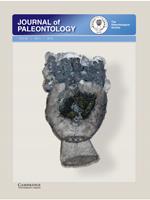Large collections of well-preserved specimens of the ammonite Baculites inornatus Meek (1862) from two lower to middle Campanian localities on the Pacific coast of North America are analyzed quantitatively to examine both variability and evolutionary change of species-level distinguishing characters. To this end, we present a new method of describing the morphology of the biostratigraphically important Upper Cretaceous zonal index fossil Baculites, using five independent shell characters that can be measured quantitatively. We then use this method to test hypotheses of phyletic evolutionary change in B. inornatus specimens collected from Sucia Island, Washington, USA, and Punta San Jose, Baja California, Mexico.
The greatest observed character change is in mature shell size: baculitids from the older of the two outcrops (Sucia islands) show a smaller mean diameter at maturity compared to those of the younger of the two outcrops (Punta San Jose). Other than this phyletic size increase, no other directional changes were observed from specimens collected at sub-meter precision from the 90 m-thick measured stratigraphic section of the Rosario Formation located at Punta San Jose. Importantly, neither the younger nor older baculitid assemblages show a size distribution of mature specimens that can be attributed to sexual dimorphism. We observed fluctuating proportions of individuals with ribs and/or keels through this section; since both characters have been used in previous taxonomic studies to define, or differentiate between, other Baculites species, our results indicate that no single character is sufficient to discriminate species within this lineage, and that there is far more variation of these characters than has previously been accepted. Our methodology can also be used to assess morphologic variation and taxonomic assignments of Baculites species in other biogeographic provinces, as well as to evaluate ecological influences on population variation and to test hypotheses of lineage evolution.





